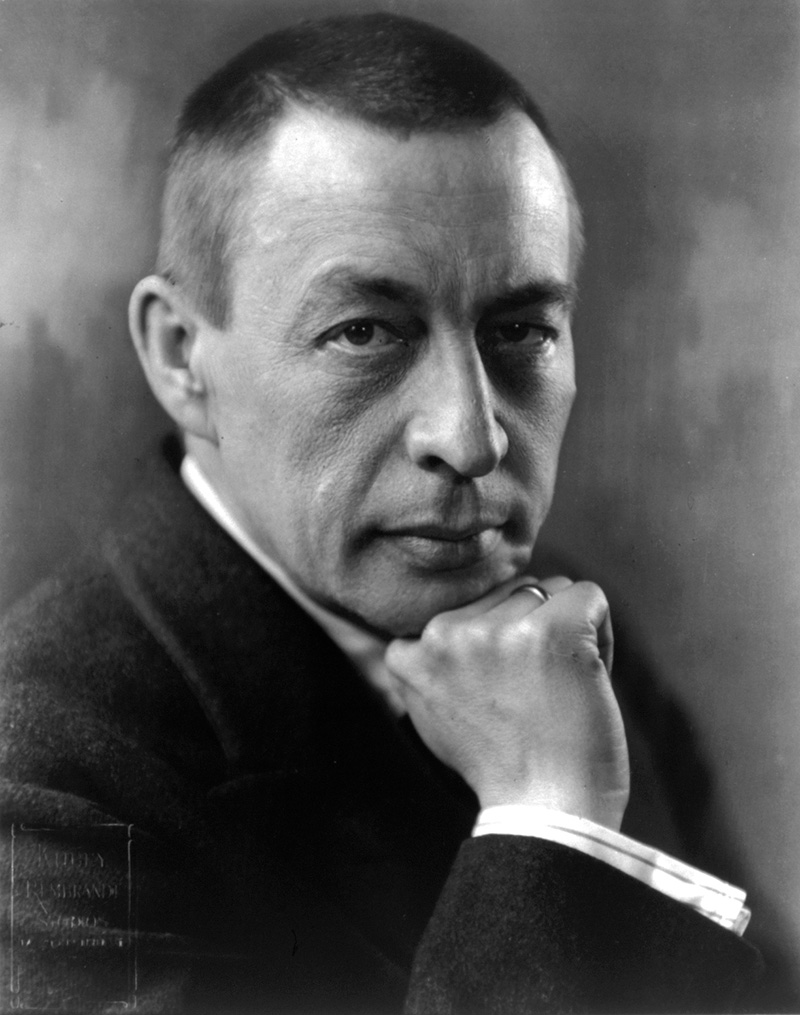Sergei Rachmaninoff

- Born: March 20 [April 1, New Style], 1873 in Oneg, near Semyonovo, Russia
- Died: March 28, 1943 in Beverly Hills, California
Concerto No. 1 in F-sharp Minor for Piano and Orchestra, Op. 1
- Composed:1891, revised 1917
- Premiere: November 9, 1901 in Moscow, with the composer as soloist and his teacher and first cousin Alexander Siloti conducting
- Instrumentation: solo piano, 2 flutes, 2 oboes, 2 clarinets, 2 bassoons, 4 horns, 2 trumpets, 3 trombones, timpani, crash cymbals, triangle, strings
- CSO notable performances: First Performance: January 1950, Thor Johnson conducting with Benno Moiseiwitsch, piano. Most Recent: January 2002, Jun’ichi Hirokami conducting with Cristina Ortiz, piano.
- Duration: approx. 22 minutes
In Russian schools, the highest grade a student can receive is a five, to which, in exceptional cases, a plus sign can be added. Therefore, the incident that took place at a harmony examination at the Moscow Conservatory in 1887 can certainly be called unusual. The committee, which included Piotr Tchaikovsky, had just heard a 14-year-old student named Sergei Rachmaninoff who had by far exceeded the requirements of the class. In addition to the simple harmonic exercises called for, the boy played some original compositions he had written. Professor Tchaikovsky took the examination book and added three more plus signs to the “5+” already there—one on top, one below, and one behind.
“My fate as a composer was, as it were, officially sealed”—Rachmaninoff recalled many years later. The youngster entered Sergei Taneyev’s class as a student of composition and soon became the star of the conservatory, even though he had the equally brilliant Alexander Scriabin as one of his classmates. The year Rachmaninoff graduated with the highest honors (1893), his one-act opera Aleko was performed in a double bill shared with Tchaikovsky’s Iolantha. Having his work on the same program with the leading Russian composer, at the Bolshoi Theater no less, was enough to launch the 20-year-old’s career. The former star student soon became the most prominent Russian musician of his generation, much sought after as a composer, pianist and conductor until his departure from Russia in the wake of the October Revolution of 1917.
The First Piano Concerto was Rachmaninoff’s first large-scale work, and the first composition he deemed worthy of an opus number. It was written while Rachmaninoff was still a student at the Conservatory, in 1890–91. Rachmaninoff performed the first movement with the school orchestra in 1892, but there is no evidence that he ever played any part of the concerto again until he revised it in 1917, although others did so over the years. In fact, in 1899 Rachmaninoff turned down an invitation to play the work in London as he thought it was not good enough. (Henry Wood, the director of the Proms, disagreed and performed the work anyway with another pianist.)
For his part, Rachmaninoff preferred to write two more concertos in 1900–01 and, in 1909, his universally popular Second and Third. Yet he did not forget about the First and continued to entertain plans of revising it. On April 12, 1908, he wrote to a friend: “I have three pieces that frighten me: the First Concerto, the Capriccio, and the First Symphony. I should very much like to see all these in a corrected, decent form.”
The Capriccio on Gypsy Themes is a weak and now entirely forgotten work, and the premiere of the First Symphony was a fiasco that left deep scars. Rachmaninoff never touched these two works again. He did eventually get around to revising the First Concerto, however. The moment came 26 years after the original version, during the politically turbulent and artistically fallow year of 1917. This revision, his last major undertaking before he left Russia for good at the end of the year, was rather extensive, involving recomposition of a large portion of the work, partial reorchestration, and a great many changes of detail. In the new version, the youthful energy of the 17-year-old is combined with the experience of a mature composer whose catalog had in the meantime reached Op. 39. The writing, although clearly influenced by the concertos of Schumann, Tchaikovsky and Grieg, nevertheless bears the unmistakable stamp of Rachmaninoff’s own personality. Virtuoso brilliance and lyrical expansiveness go hand in hand in this concerto. Rachmaninoff is usually described as a conservative composer, yet innovation is not entirely absent, as in the changing meters of the last movement, introduced in the 1917 revision.
Rachmaninoff hoped that, in its revised form, the concerto might share in the success of his Second and Third concertos. As he later wrote in a letter to Alfred Swan, a musicologist and friend:
I have rewritten my First Concerto; it is really good now. All the youthful freshness is there, and yet it plays itself so much more easily. And nobody pays any attention. When I tell them in America that I will play the First Concerto they do not protest, but I can see by their faces that they would prefer the Second or Third.
Still, as Rachmaninoff biographer Geoffrey Norris observed:
The First is a very different piece [from the Second or the Third]; the characteristic melodies, if less remarkable, are there, but they are combined with a youthful vivacity and impetuosity which were soon to be replaced by the more sombre melancholy and wistfulness of the later works.
—Peter Laki